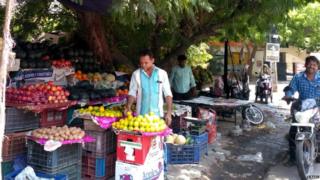
Image copyright
S.Basu
Street vendors are being denied the “right to shade” under street trees in Hyderabad, India, a study suggests.
Urban trees play an important role in providing a comfortable work environment for the city’s outdoor traders, said researchers.
They added that the urban poor’s food security was under threat if they lost access to local street vendors who were being displaced by redevelopments.
The findings have been published in the Landscape and Urban Planning journal.
The study was part of a study by Azim Premji University’s Centre for Climate Change and Sustainability to understand urban sustainability in Indian cities from the combined perspectives of ecology and social justice.
- Cities struggling to boost urban tree cover
- Project aims to grow a ‘city of trees’
- City trees ‘can boost air quality’
“It is quite evident, through multiple studies, that urban trees provide critical ecosystem services to cities across the globe,” explained co-author Sukanya Basu.
Hot in the city
However, she added that the needs of those most dependent on the trees were not taken into account.
“When we observe the streets of Indian cities, it is clear that street vendors are the among the most dependent on street trees, a highly vulnerable group who spend almost their whole working days outdoors in the hot sun,” Ms Basu observed.
“Interestingly, we could not find any literature that explores their relationships with trees.”
Image copyright
A.Bilal/Flickr
The team chose the city of Hyderabad because of its extremely hot climate, which made it especially difficult for street vendors to function outdoors.
Ms Basu added: “Given the backdrop of climate change and increasing urban heat island effects, street trees play an important role in making the daily lives of street vendors more comfortable.”
The study found street vendors were highly dependent on street trees, but their dependency was not only limited to shade, but to things such as emotional and spiritual well-being.
But the accessibility to street trees was being restricted for a number of reasons.
“We identified three broad challenges that limited the accessibility of street trees by vendors.
“First, there were only limited number of trees present on streets, of which several were felled for various reasons, such as road widening,” Ms Basu observed.
“Second, there was uneven segregation within the city. The Secunderabad street market, a highly popular street in Hyderabad, where vendor density is high, had the least number of trees.
“In contrast, streets of Banjara Hills and Jubliee Hills (affluent commercial areas), with a number of huge canopy trees had few vendors [as a result of] its location.
“Finally, redevelopment, privatisation and gentrification of urban spaces has resulted in displacement of vendors from streets, or from trees on streets because of fences, walls and obstruction by guards.”
Food security
Ms Basu said street vendors played a “significant but under-recognised role in cities”, such as providing basic security like food, clothing and other products, not only to the urban poor but also to the rest of the city, and shaping urban street culture.
But, she added: “Sadly, visions of ‘sustainable cities’ rarely include perceptions of this important urban group.”
“Town planners and policy makers need to include all voices in planning,” she urged.
“Planners and policy-makers need to understand the dependencies (personal, economic and cultural) of street vendors, and the vulnerabilities of their daily life, using this insight to reframe the nature of access to public spaces in Indian cities.
“Redevelopment, landscape designing and beautification projects cannot be done at the expense of groups like street vendors, who are not only especially marginalised, but also play a major role in shaping the economy and street culture of cities.”
Read MoreFeedzy


